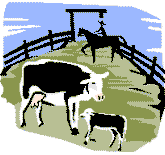



Moisture and Feedstuffs
Beef cattle producers have several feedstuffs available now that weren’t common a few years ago, says Gene Schmitz, a livestock specialist writing for the University of Missouri Extension, Ag Connection.Many of these products contain a considerable amount of water. Producers must understand how water in feedstuffs affects the amount of feed they need to provide their livestock and how moisture impacts the nutrients they are providing in the ration.
Two of the most common wet feeds are haylage and modified distiller’s grains. Both of these feeds contain about 50 per cent water. Hay and dried distiller’s grains contain about 15 per cent water. So let’s compare the “wet” version of these feeds with the “dry” version.
First, let’s consider hay vs. haylage. In 1,000 pounds of hay at 15 per cent moisture (or 85 per cent dry matter), there are 850 pounds of dry matter. A 1,200 pound beef cow that is not nursing a calf and is in mid gestation has a daily dry matter intake requirement of 24 pounds. The 1,000 pound bale of hay will feed 35 cows for one day (850 lbs. dry matter / 24 pounds dry matter per cow = 35 cows).

A 1,000 pound bale of haylage at 50 per cent moisture (or 50 per cent dry matter) will provide 500 pounds of dry matter and will only feed 20 cows for one day. In order to provide the same amount of dry matter contained in a 1,000 pound hay bale, you need to feed 1,700 pounds of haylage.
The concept is exactly the same for dry vs. modified or wet distiller’s grains. If the goal is to provide 3 pounds of distiller’s grains on a dry matter basis, you need to feed 3.5 pounds as-fed dried distiller’s grains, 6 pounds as-fed modified distiller’s grains or 12 pounds as-fed wet distiller’s grains.
Looking at this a slightly different way, 3 pounds as-fed dry distiller’s grains provides .77 pounds of protein and 2.24 pounds of TDN; 3 pounds as-fed modified distiller’s grains provides .45 pounds of protein and 1.32 pounds of TDN; 3 pounds as-fed wet distiller’s grains provides .23 pounds of protein and .66 pounds of TDN.
You must also pay attention to moisture content when you are buying feedstuffs. If you are buying haylage, modified distiller’s grains or wet distiller’s grains, you need to realize you are purchasing a considerable amount of water. These wet feeds are cheaper per ton as-fed, but may not be cheapest on a dry matter basis. Dry matter provides the nutrients, so be sure to compare feeds on an equal moisture basis.
November 2008



